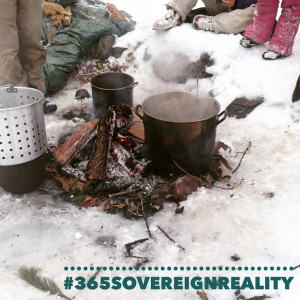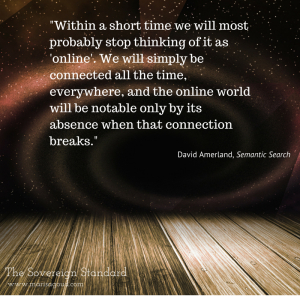
BLOG
What do your readers expect: wisdom or knowledge?
The Sovereign Standard, Issue 6
At a time when information is increasingly cheap and wisdom increasingly expensive, this gap is where the modern storyteller’s value lives.
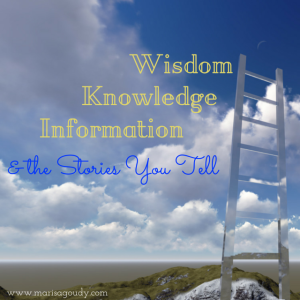 For this week’s Sovereign Standard, I was tempted to just send a link to Wisdom in the Age of Information and the Importance of Storytelling in Making Sense of the World: An Animated Essay by Maria Popova and introduce it “what she said.”
For this week’s Sovereign Standard, I was tempted to just send a link to Wisdom in the Age of Information and the Importance of Storytelling in Making Sense of the World: An Animated Essay by Maria Popova and introduce it “what she said.”
Even that title teaches you something:
Wisdom is foremost. Though we live in an Age of Information, the world doesn’t make much sense, but storytelling will help.
But, as these insights started lighting up my online and offline experience this week, I found there was something more to say. Is it wise? You tell me...
The Ladder of Understanding
Popova offers a brilliant metaphor: the “ladder of understanding.” (Turns out she’s applying Plato to our contemporary culture of noise.)
Information is everywhere - all those facts and figures and Wikipedia articles. Knowledge is the next step up - you synthesize all that information to “reveal some truth about the world.”
At the top of the ladder: wisdom. From this vantage point, you're sculpting what’s known into what matters. Through wisdom, Popova says, we understand not only how the world works, but we also present an aspirational vision of how it could work.
 Actually, she said “how it should work” but I do everything I can to avoid that word.
Actually, she said “how it should work” but I do everything I can to avoid that word.
There are moments when we crave “should” - like when you go to a trusted advisor praying they'll tell you just what to do. (The best ones will do no such thing.) The problem arises when people who have not earned the right to give such advice start doing so. Brene Brown speaks masterfully about this.
Look at the “should” problem in the context of the Age of Information and the online world: so many people who are better suited to dole out information and facts are trying to jump a few rungs of the ladder. They are moralizing - and “shoulding” - before they have the credibility and experience to impart real wisdom.
What do you share: information, knowledge, or wisdom?
Examining the Ladder of Understanding , the thought-leader-in-process leaps up waving her hands “wisdom, wisdom! I wanna share wisdom!” (Me too, brothers and sisters, me too.)
Looking at my own position, I worry that I haven’t produced enough content, and I haven’t fully birthed my signature theme in a coherent, public way. Maybe I should (eek! “should”!) put a lid on all this blogging and just cogitate on the Bigger Story a while longer if I hope to offer up any worthy wisdom.
Thank goodness Tara Mohr talked me out of that. In this wide-ranging interview (the most compelling and useful one I’ve heard her give as she promotes Playing Big), she nails that tendency to hold back and over prepare.
Mohr invites you to squash that desire to do a little more research, training, contemplating. Decide “I know enough” and get out there to speak, to launch, to interact…
“Wisdom” May Not Always Be the Right Answer
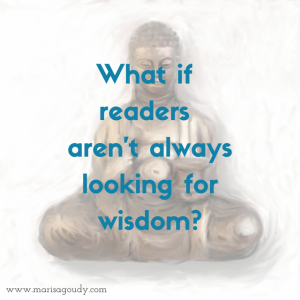 The chronic perfectionist and overachiever (is your hand raised for that too?) sees the top as the goal. If knowledge is only halfway up the ladder then it must not be good enough. And mere information? Ugh. That can’t be the realm of the creative entrepreneur.
The chronic perfectionist and overachiever (is your hand raised for that too?) sees the top as the goal. If knowledge is only halfway up the ladder then it must not be good enough. And mere information? Ugh. That can’t be the realm of the creative entrepreneur.
But are we all supposed to be climbing the ladder to the tippity top to dispense wisdom like a guru on high? Is there room up there or will too many soothsayers make that ladder topple right out of the sky?
After all, we still need that basic “how to” content to help us in anything from baking a cake to formatting a WordPress post to the basics of blogging.
And there’s great merit in collecting and organizing ideas in order to let people make up their own minds. Moralizing has its place, but sometimes it’s important to merely raise awareness and trigger curiosity. Trust your reader to refer to their own internal compass.
This week on the blog I explored the choices we have as individuals and as content creators. Every time you sit down to write you get to decide everything from the tone to the ultimate call to action. Some days a list post, some days a story that gets to the heart of the big questions.
But When You’re Called to Tell a Real Story…
A great storyteller is the kindly captain who sails her ship with tremendous wisdom and boundless courage; who points its nose in the direction of horizons and worlds chosen with unflinching idealism and integrity; who brings us somewhat closer to the answer, to our particular answer, to that grand question: Why are we here?
Popova brings her message home by employing the storyteller who navigates the deep waters of wisdom. Certainly, this is someone we can all aspire to be. Maybe not today, maybe not in that very next blog post, but certainly there are moments when you’re called to tell a story that bigger and bolder than any you’ve told before.
Godspeed on that journey.
 And yet, keep in mind what Mr. Hendrix said (or might have said): "Knowledge speaks, but wisdom listens."
And yet, keep in mind what Mr. Hendrix said (or might have said): "Knowledge speaks, but wisdom listens."
In the giving and receiving of story and silence we reveal the deepest wisdom of all.
This post was sent to Sovereign Standard subscribers first. To join our community of readers and contributors, please subscribe here.
Content Creation, Social Media, and Our Big Reciprocity Problem
 The Sovereign Standard, Issue 5
The Sovereign Standard, Issue 5
 We tend to give more than we receive. That leaves us feeling imbalanced and burned out. In such a state, the inner critic seems to find a bigger megaphone and resentment of all kinds gets free license.
We tend to give more than we receive. That leaves us feeling imbalanced and burned out. In such a state, the inner critic seems to find a bigger megaphone and resentment of all kinds gets free license.
Giving and receiving in equal measure is the art of reciprocity. Unfortunately, in this department, most of us are amateurs at best when it comes to self care, social media habits, and promoting the business.
Don't Blame the Baby for Your Self Care Deficit
If the majority are giving too much you’d think that would mean that there’s some big segment of the population getting fat on others' contributions.
First group that comes to mind - kids. Children can seem like massive energy vortexes that will suck you dry, but that’s their job, right?
Yikes! Is that sense of imbalance - and martyrdom - an inevitable part of parenting? It doesn’t have to be.
So grateful to find Jessica Michaelson’s description of a common problem we usually don't have a name for - Depleted Mother Syndrome - and what to do about it. Thank goodness every stressed out working parent doesn't have to wait two (or more!) decades to get their equilibrium back!
OK, so if children aren’t to be implicated as little vampires intent on draining their elders, and we still feel like we’re out of whack, who is there to blame?
It’s not necessarily a somebody.
Feeding the Voracious Social Media Beast
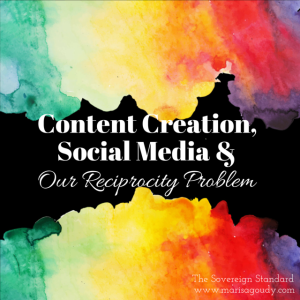 Question: Who takes but doesn’t really give anything in return?
Question: Who takes but doesn’t really give anything in return?
Answer: The social media networks that are building mega corporations based on the endless contributions of users.
Ok, the social media platforms don’t give us nothing. They give us a place to connect and an unparalleled opportunity for global visibility in exchange for our personal data and the content that lures our friends and followers to sacrifice their own privacy.
Does that feel like an equal exchange?
Here’s evidence that we’re conditioned to give more than we get. Last fall, 380 New Yorkers gave up everything from their mother’s maiden name to part of their Social Security number in exchange for a cookie.
But maybe giving it up for a cinnamon Instagram cookie doesn’t matter considering everything data brokers know about us already thanks to our buying and clicking habits.
But Social Media is About People and Relationships, Right?
We're quite used to putting away our concerns about privacy (because worrying about Big Brother is next to useless, according to this New Tech City podcast). Instead, we focus on the immediate benefits of social media - seeing and being seen.
The folks at Big Fuel explore the basics of reciprocity in social media.
They see our online presence as motivated by a dual desire to “be recognized as an individual, and belong to a community.” Online influence - something every entrepreneur wants - is the beautiful love child of posting your own content and sharing others’ stuff.
Optimistically they declare: “Whatever you give to a community, you earn in return.”
Well, that’s the ideal. That’s what reciprocity really is. But do we actually experience it much?
Paula Reed Nancarrow nudges us to witness the distracting dark side of the quest for reciprocity. Because social media is so easily quantified in followers and shares, it’s all too easy to lose focus and authenticity because you end up playing the numbers game. Reciprocity isn't about a blind series of obligatory back and forth interactions.
Reciprocity at the Human Level & the Creative Level
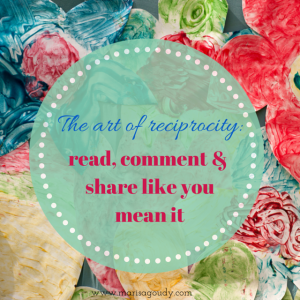 So, as we give and we give to a faceless online beast (even though we’re assaulted by countless faces every day), how do we continue to keep track of our own mission, our own creative potential, and our own humanity? How do we cultivate the art of reciprocity?I don’t have any data for this one, but don’t need it. I know my favorite solution is to read, comment, and share like you mean it.
So, as we give and we give to a faceless online beast (even though we’re assaulted by countless faces every day), how do we continue to keep track of our own mission, our own creative potential, and our own humanity? How do we cultivate the art of reciprocity?I don’t have any data for this one, but don’t need it. I know my favorite solution is to read, comment, and share like you mean it.
Writing and creating content are part of the job for most of us, but let's be honest about the days when you just don’t want to show up and churn out more ideas. You may be coping with an issue that you don’t want to share with your online community or focused on a longer term project may have your attention.
Sometimes it’s hard to write because you can’t reconcile the time it demands with the needs of the people who are right in front of you and the fear that your latest blog post won’t get a response.
In this week’s blog post, What You’ll Gain From a Business Writing Practice (Besides Blog Posts) I offer up all the ways that your writing-for-business practice gives back to you because I think that we can keep the dream of reciprocity alive.
Start with creating a positive give and take with your own creative endeavors and then apply that to your relationships with clients, colleagues, and the people you love.
It meant the world when someone I haven’t interacted with lately shared my latest post with a few heartfelt words. I quickly searched out her wonderful Hudson Valley summer camp and posted it where I could. I was motivated by gratitude and its soul sister, reciprocity.
This was not an obligatory "you scratched my back, I hafta scratch yours" share. I believe in this woman's work and she opened the door for me to share in the spirit of reciprocity with an initial act of generosity.
Look for the deeper benefits in every act of content creation to make sure you're caring for yourself. And then, read, comment, and share like you mean it to ensure you're showing your care for others.
Reciprocity is Sacred and It's Something We Can Cultivate
The indigenous peoples of the Andes have a word for profound reciprocity: ayni.
As Eleanora Amendolara of the Sacred Center Mystery School describes it “When you move through life inspired by the spirit of ayni you balance the great scales between yourself and the earth, the cosmos, and with all the people in your life.”
Listen to the Virtual Wisdom Council call that I co-hosted on topic The Rhythm of Reciprocity and Gratitude. Though we won’t be talking about entrepreneurship or your online message, Eleanora is a channel for creative magic. The discussion and group meditation offers an opportunity to see reciprocity from a broader perspective and will help you find your equilibrium.
This post was sent to Sovereign Standard subscribers first. To join our community please subscribe here.
Find the Magic and Do the Work Even When Your Creativity Freezes Up
The Sovereign Standard, Issue 3
Margaret Atwood wrote an ode to this frozen month.
“February,” she declares, “month of despair, with a skewered heart in the centre.”
Even if snow hasn’t been swirling ‘round your front door, there’s a texture to February that has people across the northern hemisphere yearning to hide under the covers. But “despair”? There are plenty who really suffer from seasonal affective disorder - it’s real, and it’s hard - but what about the rest of us who are just grouchy and feeling off our game?
We don’t have time to feel skewered when there’s a business to run and children to be entertained and a book that isn’t going to write itself.
We have to push through. But first we must acknowledge that it can be hard to find the silver in this gray and white world.
Make Friends With Reality: Reclaim the Snow Day
Remember when snow days weren’t just kids’ stuff (and massive productivity drains because there’s work to do and childcare to provide)?
Jesse Singal writes and elegy for the adult snow day in New York Magazine:
The grown-up world has a tendency to strip things of their magic a bit, but the snow day still served as a wonderful stop sign from the heavens for myopic, overworked adults. What else could grind to a halt, even temporarily, the exhausting, striving adult world of meetings and reports and office memos? What else could not only suggest to the workaholic that he take a day off, but force him to because the roads were too icy, the subways all closed? What else could unite father and son on a sled on a snowy hill in the middle of a weekday?
I too mourn the loss of the snow day and believe I’d be a better business owner and a better human if I let myself take a few more of them. While researching this week’s Sovereign Standard, I read way too many sunshine and sparkles blog posts from small business owners declaring "I don't need snow days because I love my work and my clients so much!"
Oh, please. Let's admit:
- all this snow and cold is making us feel less than... optimal
- we feel cheated of our rights to snow days (after all, it’s one of the few consolations we have when it’s so cold you can’t make it to the mailbox without the skin on your knuckles cracking)
- playing hooky as Mother Nature intends would do the business, the family, and the creative work a world of good
Everyday Creative Magic: Reclaiming the Spark of Aliveness
Again, we’re not here to despair, even as we recognize that this is the season of our discontent. Nor are we here to whine as our “bored” children home for the third day in a week are taking care of that already.
We’re here to recover some of that everyday creative magic (the kind that Singal notes has been stripped from our grown up world).
Let’s consider summer for a moment… Here in New York’s Hudson Valley, we have a treasure of an organization called Wild Earth. Many families stare down our fear of poison ivy and Lyme disease and send our kids to their camp in July.
The few and the bold send their teenagers to overnight in the woods in the middle of this deep freeze. Tyler McNamara reveals the vital pulse at the heart of winter and why experiencing and yes, embracing, this dangerous cold is essential to being alive in this piece about eighteen young adventurers.
But maybe we don’t need to sleep outdoors in order to find meaning in this dark season. Suzi Banks Baum of Laundry Line Divine shares notes from her winter retreat.
Where YOU are IS your point of entry, in to inner attention.
Wherever you are, mired in wild living or utter sameness, each are invitations to slow down, for even a few breaths and listen to what your heart requires of you. For even in the thrall of the clock, your voice is there, masked by the chaos perhaps, but it is there.
And if it isn’t the right time for you to sleep in a subzero tent or enjoy the luxury of solitude, there this sweet interview with artist, designer, and mom Johanna Winter-Harper at www.craftingconnections.net, a site dedicated to creating art with your kids. It gave me hope that it’s possible to make and mother amidst the mess.
Message: It's Never Too Frigid to Speak
 “Writing forces people to reconstrue whatever is troubling them and find new meaning in it.” So says a UVA psychologist professor quoted in the New York Times blog post Writing Your Way to Happiness. Studies show that students who engaged in “expressive writing” were healthier and performed better in school
“Writing forces people to reconstrue whatever is troubling them and find new meaning in it.” So says a UVA psychologist professor quoted in the New York Times blog post Writing Your Way to Happiness. Studies show that students who engaged in “expressive writing” were healthier and performed better in school
But we know this. Writing reveals what we really thing and who we really are (eventually). Writing is hope. Writing is healing.
Earlier this week, I dove into the places that need plenty of exploratory, personal writing, but which just aren’t the stuff of a public online presence. In Online Visibility, Transparency, and Authenticity When You’ve Got Other Things On Your Mind I hope to give you the permission to admit you’re human and that your human experience will get in front of your entrepreneurial imperatives to be visible and authentic.
Read on for a few suggestions about how to show up even when you’ve got a case of the Februaries.
Livelihood: How Winter Impacts Work
Finally, a few practicalities about winter and the business world...
Economists don’t really know if snow storms negatively impact the economy. Apparently, “it’s more an art than a science” to figure out whether lost wages, delayed purchases, and all those flight delays have a long term impact.
If you run a brick and mortar business when the roads are closed or have remote employees who can’t work because an ice storm knocked out their power, do you pay them? This article from Entrepreneur is a place to start.
Ultimately, How Will You Survive February?
Clinical psychologist Paul Lichtenberg posts on his Facebook page:
It reminds us that self-care: in the boiling of the tea, rinsing with salt, epsom baths, sitting, gentle restorative yoga, soup, slow mindful walking, self-massage, asking for help; all these minute-to-minute actions with the intention to heal bodymind bring us back to the most simple message: be kind to oneself, be gentle, care for the body and quiet mind. That is healing.
In this case, Paul is talking about coping with mortality, but we can use this wisdom to navigate the last weeks of this frozen world.
And so, we can move through, taking what medicine is available and appropriate to our temperament. We can occupy the present moment and actively seek healing and vitality, rather than mere survival.
Or, write a hot harangue at a poor blameless cat. Atwood’s “February” that opened this week’s issue is actually addressed to a feline who insists on sneaking into her bed. Proof that “kick the cat” syndrome is real, even in Booker Prize winners:
Cat, enough of your greedy whining and your small pink bumhole. Off my face! You’re the life principle, more or less, so get going on a little optimism around here. Get rid of death. Celebrate increase. Make it be spring.
How Business and Creativity Thrive When You Go Beyond the Online/Offline Divide
There are no barriers between the real world, the digital world, and the creative world Remember how there used to be was a wall between “real life” and our internet habits?
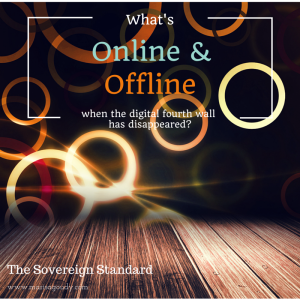 Maybe you had a blog you never talked about with friends. Perhaps you used to feel like your connection to online business contacts was somehow different from your relationship to local clients and colleagues.
Maybe you had a blog you never talked about with friends. Perhaps you used to feel like your connection to online business contacts was somehow different from your relationship to local clients and colleagues.
Those barriers and distinctions have all but vanished. And with the disappearance of the fourth wall between our online and offline lives, everything has gotten simultaneously more simple and more complicated.
We are both actors and spectators in the electronic and the terrestrial world. We can't go on believing that one space is make believe and the other reality and hope one has no influence upon the other.
When I first started asking questions about the way we performed in our digital and in our analog (read: real) lives, I was troubled that most people didn't seem invested in the topic. Finally, its time has come and we’re all thinking about what the phones and the social media presence is doing to our relationships, our work, and our creativity.
What Photos and Videos Offer… and What They Take Away
Last spring, when typing was nearly impossible thanks to the infant in my arms, I experimented a lot with video. Despite the low production value product, it was an important exercise in visibility and finding my voice in a time that might otherwise have been very insular and isolated.
Online and Offline Balance in Business, Life, and Family highlights the questions I was asking related to the future of Online Empowerment (which is having its own exciting new future without me), but I lay some much bigger questions on the table thanks to inspiration from David Amerland’s Semantic Search:
Forward thinking questions aside, it's worth noting that I have absolutely no memory of making that video. Was it mommy brain (see that I was holding a sweet faced girl who was still working to keep her head up!) or was it "photo-taking impairment effect"?
This NPR story talks about how capturing an image alters the quality of our memories and experiences is part of a bigger conversation going on about how cell phones are squelching creativity.
So, if our brains are being repatterned by our tech habits, what does that do to our business practices?
Livelihood: Thank Goodness We’re Not Digital Marketers!
At this point, we’re pretty much past the question of whether you can build a brand or a platform without social media (though it still gets asked).
Instead we’re seeing that online marketing is so ubiquitous that people are catching attention with headlines like Social Media Has Killed Consumer Trust.
According to Sensei Marketing, the “pendulum has swung back to traditional word of mouth and away from “the wisdom of crowds.’” That means we’re done using “likes” as barometers of quality and are re-dedicating ourselves to the tried and true “ask a friend” approach.
But as creative entrepreneurs, aren’t we “digital marketers”? We blog and tweet and sweat out our online visibility because we know it’s how we’ll grow a business and share our unique wisdom with those who need it most.
This is when we must remember we’re always going to rely on relationships and personal recommendations in a way that the digital marketing behemoths cannot. You are not Coke or Apple (thank the gods!). You are you, and that is so much more attractive to the individual clients you wish to reach.
By virtue of being a real person you are already bridging the real life/digital divide. Now, just be yourself.
Remember: that fourth wall between actor and audience, digital you and real people has fallen down - permanently. There has never been a better time to be a human being talking to another human being, regardless of whether it's face-to-face or over Facebook.
Message: How to Play Nice and Learn Something, Regardless of Medium
There’s a simple way to break down that final barrier between our online and offline consciousness: Stop believing there’s a difference between them. Lany Sullivan reminds us that the social side of media is not different from the social side of life.
That brings us to my favorite post of the week: Building up your swipe copy files: how to make the most of the B-school bombardment. Tanja Gardner of Crystal Clarity Copywriting makes the ultimate lemonade from the Marie Forleo-stamped lemons that will start filling our inboxes and newsfeeds.
Tanja's response - to watch and learn rather than grouse and delete - felt like a grounded, “real life” reaction to unwanted solicitation. After all, when you meet someone at a networking meeting and they’re promoting something that doesn’t interest you, you can’t just roll your eyes and click delete or unsubscribe. Instead, you find a way to engage and find the point of connection (because really, the person pushing B School is probably still awesome even if she’s obviously motivated by a nice affiliate fee).
Everyday Creative Magic: Knowing When to Engage & When to Turn Within
Every breathing moment is part of our reality, regardless of whether we're glued to a screen or wholly entranced by a sunset, but we still need to protect the primal realms will forever resist hashtaggery.
Our creativity depends on quiet incubation time that can’t yet stand the light of day - or the glare of the screen. Jeffrey Davis offers this video on how to shape online and offline time to balance the “in the woods” and “in the sun” time.
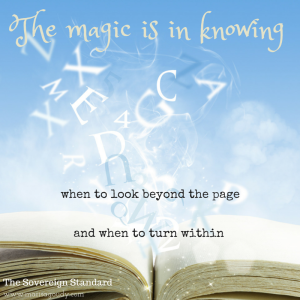 If you’re in the flow and the BIG IDEAS are filling up the journal, please don’t stop writing. When you do emerge from your writer’s den, however, you don’t necessarily have to spread yourself thinner to show up on social media - unless you want to. You have (at least) four choices about how to approach digital publishing and your online platform when you’re working on the bigger story.
If you’re in the flow and the BIG IDEAS are filling up the journal, please don’t stop writing. When you do emerge from your writer’s den, however, you don’t necessarily have to spread yourself thinner to show up on social media - unless you want to. You have (at least) four choices about how to approach digital publishing and your online platform when you’re working on the bigger story.
And if you’re feeling like that private creative flow is elusive and you’re being drained by all the digital obligations and distractions, open yourself up to Nancy Seibel’s list of creativity boosters that don’t require a WiFi connection.
The “Problematizer”
One of my favorite college professors coined the term “problematizer” and generally used it to describe any person or idea that disrupted business as usual in Catholic Ireland. The problematizer tended to tip over a few sacred cows, and that's important to the Sovereign Standard ethos too - though we don't limit ourselves to topics in Irish studies!
For all this conscious examination of the online/offline continuum and the reality of both spheres, there are times we like using the online world as a wall to hide behind.
Scary Mommy boldly owns the truth: we use our devices to escape boring, painful situations. Maybe we're goofing off and spacing out. Often we're preoccupied with the phone because we just need to get some work done so we have a shot at cooking dinner instead of serving up another frozen pizza.
And sometimes, that’s gotta be OK too.
This is the second issue of the weekly curated publication, The Sovereign Standard. Get the next issues delivered to your inbox by signing up today.
Set Your Own Sovereign Standard
You know those magical creative moments when it all just flows? The story or the business idea or the picture emerges and it’s like it was just waiting for you to finally discover it. That’s what it was like for The Sovereign Standard, this new weekly curated newsletter.
In the midst of a typical family Saturdaymorning, the idea announced itself:
The Sovereign Standard takes its stand at intersection of livelihood, message, and everyday creative magic and aims to give creative entrepreneurs access to noteworthy insights from across the web.
But you know how it is - you careen from visionary brilliance to obsessive wordsmithing. All the initial genius leaches out and the concept begins to feel overanalyzed and underdeveloped.
Sometimes the fault line in an idea stems from a single word.
The flaw in the initial Sovereign Standard “download”? “Intersection.”
Intersection indicates that business and communication and creativity all merge, but it also implies that they’re distinct tracks that are only drawn together from time-to-time by a project like this one.
In truth, you're constantly braiding together of all those strands - all of the elements of life and work, body and soul. To set your own Sovereign Standard, you take all aspects of your life into account and, consciously as you can, integrate them all.
Why Would a Writer Want to Curate Other People’s Stuff?
Thanks for starting with me from the very beginning. Here’s a window into the “why” of this new Sovereign Standard adventure.
In a word: connection.
The goal of a weekly round up + commentary is to expand your connections in a meaningful way by introducing you to fellow creative entrepreneurs as well as leading thinkers in business, creativity, and progressive leadership.
The Sovereign Standard community may be rich with solo entrepreneurs, but this is not a bastion of the DIY mindset. To borrow a term from a great community builder, Jeffrey Davis of Tracking Wonder, it’s about DIT - Do It Together.
Jeffrey names the contradiction that so many creative entrepreneurs face: “We want to feel supported in our work, but when we receive it, we don't know what to do with it. We don’t trust it.” In this detailed and, yes, lengthy piece he lays down a compelling case for why support and collaboration are vital to even the most brilliant solo acts.
That support may be found in hiring a WordPress whiz or a writing coach. You may get the support you need by simply opting into the e-newsletters that really speak to you.
In the process of building up this publication, I’ll also build my own connections as I read with your needs in mind. I get to create relationships with smart, tuned-in writers and media makers who are saying things that matter.
And, yes, I admit that I am working to build my email newsletter list. I trust that the insights carefully gathered from at least a dozen other sources will be more compelling than sending you the same single voice each week.
These aren't new ideas. They don't have to be.
Think you may want to build community in a similar way? You wouldn't be copying me. You’d be joining a growing cadre of content curators who understand that their tribe is plagued by information overload. Your tribe would appreciate it if someone they trust would handpick some “must reads” each week.
I trust Copyblogger products and after investing many car rides in the Rainmaker podcast, I can tell you I trust their CEO Brian Clark’s instincts.
He has launched his own new curation project. The process is detailed in three episodes beginning with this on Content Curation Positioning. I immersed myself in this topic over the last few weeks and can also recommend an earlier episode that gives an overview of the entire curation as content concept.
Soon you’ll notice that many of the people you trust most on the web are building a community by assembling useful, compelling resources all the time.
The day before I announced a weekly feature that would speak to livelihood, message, and creativity, I came across Gina Fiedel’s article that drew those exact ideas together - and curated the hell out of some quality content too.
Her post, which ostensibly focuses on how to connect to your creativity even when trying to feed the content beast blossoms into a chorus that celebrates the blending of writing and marketing, creativity and productivity, and work and play.
Gina offers: “Here’s a secret I told myself. If I start with play and if I continue in that vein, what I end up with contains more overall creative style and elements than if I hadn't done that. I achieve both creative process and (hopefully) a creative product.”
This is the delightful pivot point. All this writing, all this curating, all this community building that our work depends on is enlivened by play.
Play is How We Make Friends and Build Connections
Play is the space we learn how to engage with others. Play is also the space we learn to engage with ourselves.
Play makes taking risks feel less threatening. Play is riddled with successes and failures. It’s suppose to be. Failing means learning.
Play is how we learn and grow; long into adulthood. Play is a doing activity, not a trying activity. We don’t try to play, we play.
When you're hooked on productivity, play seems like a chore. We work to build community (yep, I say above that I am "working to build my email list"). But really, do we win friends through work or play? Really, any newsletter list worth having is full of people you'd like to call friends.
Better to attract new friends to your hive with the sweetness of play rather than the sweat of work, right?
Recently I’ve been redefining play in my house to make for our collective imagination and really see one another. If knocking a few Disney Princesses off their thrones appeals to you, check out When You Wish Upon Someone Else’s Marketing Star.
Saundra Goldman of The Creative Mix is a self-professed “serious girl” (but I can attest she has a great laugh!). She is making 2015 the year of #ContinuousPractice. This #365project is intended to document her daily writing practice and to encourage others to show up to their creative endeavors each day.
Though not ostensibly about play, sharing evidence of your daily practice can build connections in much the same way that playing can… You show your authentic self and you dare to be vulnerable. You invite people close in a way that efforting never quite permits. Since you're not a photographer it's ok if every image isn't perfect.
It’s an honor to know that Saundra credits me with inspiring her photo-a-day project. My 365 Project as a Creative Process appeared on her blog recently. Just a few other creatives who have picked up the 365 habit include Brenna Layne (#rootsandwings), Ginny Lee Taylor (#livetrue), Deirdre Walsh (#justbreathe), and Lauren Ayer.
As Saundra asks, “What would it take to make today Day One?” If you need a little more encouragement or incentive to consider launching your own #365 project, here’s a post on how daily photos make you a better writer. If it feels overwhelming you may want to modify the yearlong project to suit your needs and resources.
But Is Everything Supposed to Be Integrated?
I’m a self-avowed #365project evangelist, but what are the downsides to all that photo snapping and sharing? Is it play or process? Is it obsessive brand building? Is it an exploitation of your own intimate moments?
In When a Picture Breeds A Thousand Questions Blair Glaser asks some probing questions about why we’re motivated to capture a sunset and then share it. Blair concludes “I write this post not as a judge, but as a witness: A witness to the changes that are happening in my business, in my brain, in my life, and in the way our culture is shaping these changes.”
She then introduces the Bored and Brilliant project from WNYC’s New Tech City podcast. It’s a collective experiment in putting down the phone and embracing the power of daydreaming. This is “challenge week” and they’re putting out daily podcasts encouraging you to change your phone behavior.
Tuesday’s challenge: don’t take a photo. Not only do I have a photo-a-day commitment, but it was my daughter’s first birthday, so I failed miserably (but cheerfully).
Listen to the episode (only 6 minutes) and make up your own mind about the “photo taking impairment effect” and whether it’s detracting from life as you’re living it. I won’t be quitting my #365SovereignReality practice, but I will be monitoring how I’m using the camera to witness the moment and decide if I'm shortchanging my senses and my memories.
Setting Your Own Sovereign Standard
This is the first step in a new adventure - finding the Sovereign Standard that serves each of us as individuals, but doing it collaboratively.
To get The Sovereign Standard delivered each week (and to let me know you'd like to be featured in future editions), sign up today.


